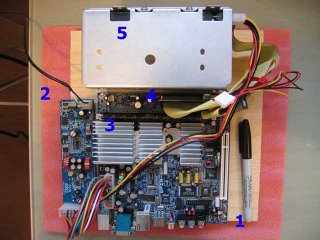The Hardware
As I mentioned in the intro, our little media network will initially have two nodes.
First, the server, which we shall christen "Backfire", because it is large, loud, and ungainly:

Wow. Okay, so the labelling didn't turn out so good. Anyways, these are some of the components:
This stuff isn't cheap - at least, not on my budget. But I got a sweet deal on the processors and the RAM, and the rest of the gear came to about $900CAD total. You could definitely save a few hundred bucks and go with a cheaper motherboard, for instance the ASUS K8N-DL. I went with the Tyan 'cause it's got a little more room for expandability. And the rackmount ... well, that's a bit of an extravagance. But I've always wanted a rackmount.
The first client in this network will be a Mini-ITX based PC, which we shall name "Fulcrum" because... well, because I like that name.

(Sharpie provided for scale)
Well, that's what we've got to work with! Let's see how far we can get...
First, the server, which we shall christen "Backfire", because it is large, loud, and ungainly:

Wow. Okay, so the labelling didn't turn out so good. Anyways, these are some of the components:
- Antec 4U Rackmount (no, I don't have a rack in my house. But I have a sturdy shelf, and a large storage space under the stairs. It'll do, for now...)
- Dual Opteron 248's. This server is going to be doing a lot of stuff other than acting as a server for this project. These 64-bit processors ought to give it plenty of horsepower.
- The cheapest PCI-express video card I could find. This thing will be running headless, so I just needed the video card to get it set up. I believe it's an NVidia 6200.
- The motherboard, a Tyan Thunder K8WE (minus the SCSI controller). Stocked with 2Gb of PC3200 RAM, or 1Gb per processor.
This stuff isn't cheap - at least, not on my budget. But I got a sweet deal on the processors and the RAM, and the rest of the gear came to about $900CAD total. You could definitely save a few hundred bucks and go with a cheaper motherboard, for instance the ASUS K8N-DL. I went with the Tyan 'cause it's got a little more room for expandability. And the rackmount ... well, that's a bit of an extravagance. But I've always wanted a rackmount.
The first client in this network will be a Mini-ITX based PC, which we shall name "Fulcrum" because... well, because I like that name.

(Sharpie provided for scale)
- The centrepiece of this computer is the Via EPIA SP800 motherboard, an 800Mhz motherboard with onboard LAN, Video, TV-out, and sound in a 17cmx17cm form factor. I strongly recommend the folks at Logic Supply as a source for this part - they were great to me even when some trouble arose with shipping that was not at all their fault. The SP800 is currently the fastest fan-less motherboard Via makes. As I mentioned, one of the goals of this system is to have no moving parts.
Another advantage to the SP800 is that it has some hardware built-in to help out with video and audio encoding/decoding. This means that the CPU doesn't have to busy itself with these tasks, and will be available to do other stuff while we're watching a movie or playing an MP3.
- Power is supplied to the board by a 60W DC-DC converter and a 12VDC power supply. This is the Morex 60W kit available from Logic Supply.
- 512 Mb of PC3200 RAM. Because I hope to construct a read-only file system (I'll get to that in a minute), it would be good to have as much RAM as possible. The SP800 supports up to 1Gb but I only had a 512Mb stick lying around.
- A Compact Flash/IDE adaptor. This is also available from Logic Supply (those guys are great, did I mention that?) The idea here is to load the operating system up onto a compact flash card and have the computer treat it just like a regular hard drive. But because compact flash only supports a limited number of write cycles (granted, a large number), we need to make it read-only.
- A hard drive cage, with a 6Gb hard drive inside. We'll use this disk to get everything set up, and only cut over to the compact flash at the last minute.
Well, that's what we've got to work with! Let's see how far we can get...

2 Comments:
you got wood
By metamator, at 1/24/2006 11:54 AM
metamator, at 1/24/2006 11:54 AM
you got male.
By gwilli, at 1/25/2006 5:23 PM
gwilli, at 1/25/2006 5:23 PM
Post a Comment
<< Home